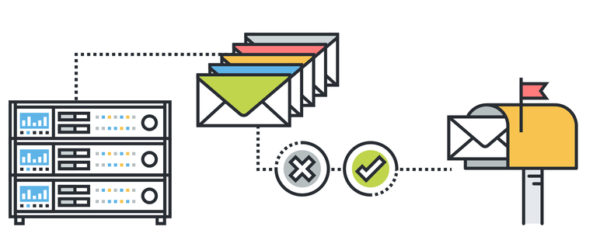Have you waited too long for your bill to get paid, but ended up with your email has been put into the spam folder? Which is pretty annoying and you have to look into the reason.
One of the big reasons that your emails go to spam is that spam filtering has become more rigorous. Webmail providers are simply cracking down on spam. However, the filters aren’t 100% accurate, so sometimes legit emails go to spam too.
There are multiple reasons can get your email blocked or dumped into the spam folder, both technical and operational, and the primary reason is based on the Cyber security assurance. So if your administrator configured the email properly, the likeness of being rejected or mislabeled is minimal. let’s have a look at them one by one:
There are three primary objectives of securing communications:
- Authentication – Guarantees that the message is not a forgery and does actually come from whom it states.
- Integrity – Guarantees that no one intercepted the message and altered it; similar to a checksum function in a frame.
- Confidentiality – Guarantees that if the message is captured, it cannot be deciphered.
SPF and DKIM are there to ensure these objectives met.
DNS SPF record (Authentication)
To thwart spammers from pretending to be sending email from your domain (spoofing), use your DNS to specify your outbound email server. Many email servers are now checking inbound email to see if the email is authorized by the SFP record.
According to Wikipedia:
“Sender Policy Framework (SPF) is an email authentication method designed to detect forging sender addresses during the delivery of the email. SPF alone, though, is limited only to detect a forged sender claimed in the envelope of the email which is used when the mail gets bounced … SPF allows the receiving mail server to check during mail delivery that a mail claiming to come from a specific domain is submitted by an IP address authorized by that domain’s administrators.”
Use an SPF record in your DNS configuration to prevent being blocked. One popular test email servers are performing is to test whether the server has permission to send email on the behalf of the domain. If the email server sending the outbound email is not listed in the SPF record, which potentially can be a dodgy sender, the email bounces or is put in the spam folder.
The SPF record is usually in the format below:
your-domain.com. IN TXT "v=spf1 a mx ip4:XXX.XXX.XXX.XXX -all"
DKIM (Integrity, Confidentiality)
With SPF your email can proof itself is from the valid server, but what if your email has been tampered with in transit, so DKIM (DomainKeys Identified Mail) came into the picture.
” DKIM allows the receiver to check that an email claimed to have come from a specific domain was indeed authorized by the owner of that domain.It achieves this by affixing a digital signature, linked to a domain name, to each outgoing email message. The recipient system can verify this by looking up the sender’s public key published in the DNS. A valid signature also guarantees that some parts of the email (possibly including attachments) have not been modified since the signature was affixed.”
When the MTA generates the signature, the public key used to generate it is stored at the listed domain. After receiving the email, the recipient MTA can verify the DKIM signature by recovering the signer’s public key through DNS. The recipient MTA then uses that key to decrypt the hash value in the email’s header and simultaneously recalculate the hash value for the mail message it received. If these two keys match, then the email has not been altered, giving users some security knowing that the email did originate from the listed domain, and that nothing has modified it since it was sent.
Your IP Address Was Used for Spam
Even if you never send spam yourself, your emails could get flagged as spam if your IP address was used by someone else for spam.
For example, if you send your campaigns through an email marketing service, your email is delivered through their servers. So if even one other customer sends spam, it could affect your deliverability as well. Or even worse, your email server has been hacked and being used to send spam without your notice.
You can check it at https://www.spamhaus.org/query/ip/xxx.xxx.xxx.xxx , https://mxtoolbox.com/blacklists.aspx
Email header is altered
When you reply to email, the reply is normally sent to the address specified in the From field of the original mail. What if you didn’t want to receive replies at the From address? Such as you setup a contact form on your website, send from an email address that does not exist, and you added an email to reply-to header. This also could lead to being marked as spam due to the mismatch of From address and reply to address.
Apart from these technical reasons, there are other reasons your email may get blocked:
Your Subject Line is Misleading
As the CAN-SPAM act states, it is actually against the law to intentionally mislead someone with your subject line in order to induce them to view the message.
In a survey conducted by Litmus and Fluent, over 50% of participants stated that they have felt cheated, tricked or deceived into opening a promotional email by that email’s subject line.
Here are some examples of misleading subject lines:
- Did I leave my jacket at your place? This type of subject line can be used as a trick to make it look like they know you.
- RE: CURRENTLY IN OFFICE is doubly sneaky because it can be mistaken for a reply to your email or a work-related email.
- Urgent – Update your information. If something says “urgent,” it had better be urgent.
- Thanks for your order! It’s super poor form to use a transactional subject line if the email isn’t actually transactional.
You sending email to your subscriber without unsubscribe link
No matter how valuable you think your email campaigns are, you still need to give your subscribers a way out. If you don’t, you could get spam complaints (at best), or slapped with thousands of dollars in fines.
At the bottom of your emails, include an unsubscribe link or a similar opt-out feature.
You Used Spam Trigger Words
Some spam filters are triggered by certain words in the subject line or the body of the email. Some spam trigger words are:
- cancel at any time
- check or money order
- congratulations
- dear owner
- for only ($)
- free or toll-free
- great offer
- guarantee
- increase sales
- order now
- promise you
- risk-free
- special promotion
- this is not spam
- winner
Your email provider may have a built-in tool that checks your emails for spam trigger words before sending it. Alternatively, you can also use ISnotSPAM, a free tool which scores your emails for deliverability and to see if they’re likely to trigger spam filters.
Test if your email can be marked as spam
There are a couple of free email spam tester online for you, test regularly to make sure your email can see the light of inbox:
- https://www.mail-tester.com/
- http://isnotspam.com/
How to fix the issue
- Tell Subscribers to Whitelist Your Emails.
- If possible, do not send HTML-only messages (send plain-text messages instead, or multi-part MIME messages with a text/plain component).